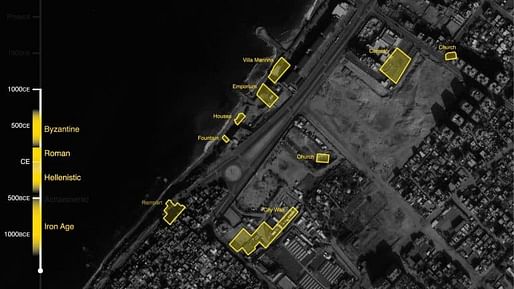

Fresh off its recent Peabody Award win, London-based Forensic Architecture (FA) has returned to one of its most popular research sites with a new project, called “Living Archaeology in Gaza,” examining the fate of an important archaeological site under assault in the Gaza Strip.
The site in question was tentatively added to UNESCO’s list of World Heritage Sites in 2012 but has since been closed off to further archaeological research and beset by damaging new construction. The group examined ten years' worth of data collected by the French Biblical and Archaeological School of Jerusalem between 1995 and 2005 to produce 3D renderings of an ancient city called Anthedon that existed for two millennia until about the High Middle Ages.
What they discovered was that Israeli bombing and consolidation, combined with climate change-caused coastal erosion, has placed a considerable strain on the site, which counts among its ruins examples of building from the Byzantine, Greco-Roman, Babylonian, Neo-Assyrian, and Early-Islamic civilizations.
“Where traditional archaeology reconstructs the lived experience of people through their material remains, this form of open source archaeology opens up a vaster timeline that establishes the relation between each historical layer,” the report's authors wrote. “Through this stratigraphic succession that extends from the ancient past to the contemporary present, we reveal a story of continuity of inhabitation.”

FA once again used a blend of civilian video, historic models, social media data, survey photographs, historical maps, and more methodologies to construct an accurate timeline of the site and its numerous incursions. The report also included a legal analysis from the Palestinian group Al-Haq in which the case is made that Israel has continuously committed crimes against cultural property in its hypocritical pursuit of archaeological digs which support only narratives convenient to their claim on the land and the attendant criminal occupation that it engenders.
“On one hand, cultural heritage sites that serve this narrative and are directly controllable by the Israeli Occupying Forces are appropriated and exploited to reinforce this narrative. On the other hand, cultural heritage sites that conflict with this narrative are, straightforwardly or not, targeted, damaged and destroyed, in an attempt to erase them from memory.”
The report will now be sent to the prosecutor’s office at the International Criminal Court (ICC) for further review. The full investigation can be accessed here. Its authors summarized the significance as follows:
“Archaeology in Palestine has deep colonial roots. Colonial archaeology prioritizes certain periods of interest and rarefies them, while the findings of biblical archaeology in particular have been used for centuries to displace, exploit, and erase cultures living on the surface. The practice and deployment of archaeology has thus tended to be disconnected from the daily realities within which it is located, to disregard local knowledge and to silence the lived experience around or above it. Heritage preservation has often sanitized and decontextualized the very sites and objects it aims to protect.”
No Comments
Block this user
Are you sure you want to block this user and hide all related comments throughout the site?
Archinect
This is your first comment on Archinect. Your comment will be visible once approved.